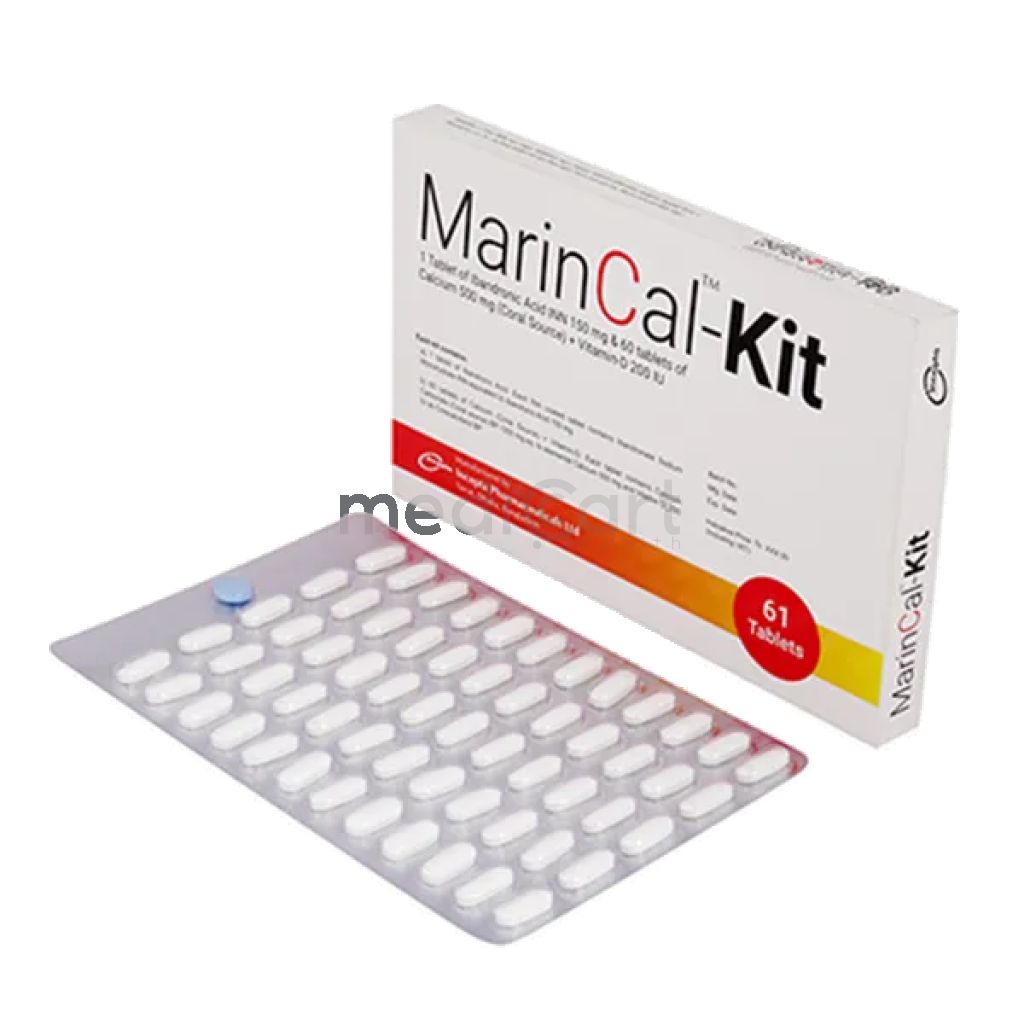

Marincal KIT - 150mg
Tablet
Pack Size :
1 Strip x 1 Box
Generics :
Ibandronic Acid + Calcium + Vitamin D3
Manufacturer :
Incepta Pharmaceuticals Ltd.
Best Price *
TK
990.00
* Delivery will be done in Dhaka city only.
Alternative Product
More Information About - Marincal KIT - 150mg
Description
Generic Name
Ibandronic Acid + Calcium + Vitamin D3Precaution
Ibandronic Acid Upper Gastrointestinal Adverse Reactions: Ibandronic acid like other bisphosphonates administered orally may cause local irritation of the upper gastrointestinal mucosa. Because of these possible irritant effects, caution should be used when Ibandronic acid is given to patients with active upper gastrointestinal problems (such as known Barrett?s esophagus, dysphagia, other esophageal diseases, gastritis, duodenitis or ulcers). Hypocalcaemia and Mineral Metabolism: Treat hypocalcemia and other disturbances of bone and mineral metabolism before starting therapy. Musculoskeletal Pain: Severe and occasionally incapacitating bone, joint, and/or muscle pain has been reported in patients taking Ibandronic acid and other bisphosphonates. Jaw Osteonecrosis: Osteonecrosis, primarily in the jaw, has been reported in patients treated with bisphosphonates. Most cases have been in cancer patients undergoing dental procedures, but some have occurred in patients with postmenopausal osteoporosis or other diagnoses. Calcium (Coral) and Vitamin-D In mild hypercalciuria reduction of dose is sufficient to return to normal serum Calcium concentration. Plasma and serum Calcium level should be monitored in mild to moderate renal impairment patients and also in case of long term use. Patients with renal stone or with such previous history should be recommended to increase their fluid intake.Indication
Treatment and prevention of osteoporosisContra Indication
HypersensitivityDose
One tablet of Ibandronic Acid 150 mg once monthly on the same date of each month is recommended. To maximize clinical benefit of Ibandronic acid, two tablets of Calcium (Coral Source) 500 mg and Vitamin D 200 IU per day are usually recommended in divided dosage. Day 1 Take the Ibandronic Acid tablet (as mentioned 'Day1' on the strip) on an empty stomach at least 60 minutes before the first food or drink (other than water) of the day or before taking any oral medication or supplementation including Calcium, Antacid and/ or Vitamins Swallow tablet whole with a glass of plain water while standing or sitting in an upright position Avoid lying down for 60 minutes Do not chew or suck the tablet Day 2 -31: One tablet of Calcium and Vitamin D should be taken at the morning and at the evening after mealSide Effect
Pain or trouble with swallowing , Constipation, Chest pain, Diarrhea, Heartburn (esophagitis), Pain in extremities (arms or legs), Flatulence, Dyspepsia (upset stomach Allergic reaction.Pregnancy Category
Name : C
Description
Animal reproduction studies have shown an adverse effect on the fetus and there are no adequate and well-controlled studies in humans, but potential benefits may warrant use of the drug in pregnant women despite potential risksMode of Action
Ibandronic Acid (Ibandronate Sodium Monohydrate) is a nitrogen- containing bisphosphonate that inhibits osteoclast-mediated bone resorption. The action of Ibandronate on bone tissue is based on its affinity for hydroxyapatite, which is part of the mineral matrix of bone. Ibandronate inhibits osteoclast activity and reduces bone resorption and turnover. In postmenopausal women, it reduces the elevated rate of bone turnover, leading to, on average, a net gain in bone mass. The combination of Coral Calcium and Colecalciferol is composed of Calcium Carbonate with small amounts of Magnesium and other Trace minerals. Coral Calcium ensures better absorption than Calcium of other Calcium Carbonate origin due to its chemical structure that is very similar to the composition of human bone Calcium Carbonate. Vitamin-D aids in the absorption of Calcium from GI tract and helps to maintain Calcium balance in the body.Interaction
Ibandronic Acid Products containing calcium and other multivalent cations (such as aluminum, magnesium, iron), including milk, food, and antacids are likely to interfere with absorption of Ibandronate. It is also found to interact with H2 blockers such as Ranitidine in several clinical trials.. Calcium (Coral) and Vitamin-D Oral Calcium can reduce the absorption of tetracycline & fluoride preparations and minimum 3 hours? time should be allowed between ingestion of these medications. Thiazide diuretics reduce the renal excretion of Calcium. Phenytoin, barbiturates, glucocorticoids may induce metabolism of Vitamin D. Concomitant intake of certain foods like spinach, cereals, milk and its derivatives may reduce the intestinal uptake of Calcium.Pregnancy Category Note
Pregnancy: There are no adequate and well-controlled studies in pregnant women for this kit. This kit should be used during pregnancy only if the potential benefit justifies the potential risk to the mother and fetus. Nursing mother: It is not known whether this kit is excreted in human milk. Because many drugs are excreted in human milk, caution should be exercised when this kit is administered to a nursing woman.Adult Dose
Oral Adult One tablet of Ibandronic Acid 150 mg once monthly on the same date of each month is recommended. To maximize clinical benefit of Ibandronic acid, two tablets of Calcium (Coral Source) 500 mg and Vitamin D 200 IU per day are usually recommended in divided dosage. Day 1 Take the Ibandronic Acid tablet (as mentioned 'Day1' on the strip) on an empty stomach at least 60 minutes before the first food or drink (other than water) of the day or before taking any oral medication or supplementation including Calcium, Antacid and/ or Vitamins Swallow tablet whole with a glass of plain water while standing or sitting in an upright position Avoid lying down for 60 minutes Do not chew or suck the tablet Day 2 -31: One tablet of Calcium and Vitamin D should be taken at the morning and at the evening after mealChild Dose
N/ARenal Dose
N/AAdministration
Tablets should be taken in order as directed on the blister strip for ease of dose tracking. Swallow tablet whole with a glass of plain water while standing or sitting in an upright position Avoid lying down for 60 minutes Do not chew or suck the tabletDisclaimer
The information provided herein are for informational purposes only and not intended to be a substitute for professional medical advice, diagnosis, or treatment. Please note that this information should not be treated as a replacement for physical medical consultation or advice. Great effort has been placed to provide accurate and comprehensive data. However, Medicart along with its authors and editors make no representations or warranties and specifically disclaim all liability for any medical information provided on the site. The absence of any information and/or warning to any drug shall not be considered and assumed as an implied assurance of the Company.





